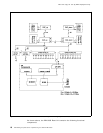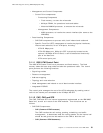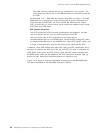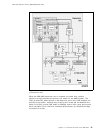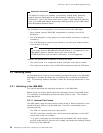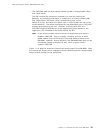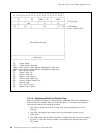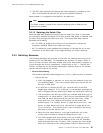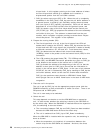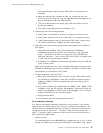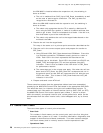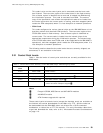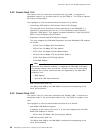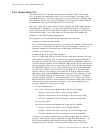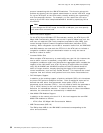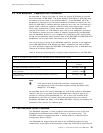This soft copy for use by IBM employees only.
4-byte block. A 4-bit register pointing to the lower address of where
the next 4-byte block should go is updated and is used as a
displacement pointer from the cell buffer address.
f. CAD_Up writes
source port (SP)
in RH. When the cell is completely
assembled in the CAD_Store, CAD_Up puts the cell buffer address in
a general queue, to allow for cell assembly ending almost at same
time (one cycle of SFE_Up/CAD_Up interface). Each cell will then be
dequeued on a first-in/first-out basis from the general queue, and
CAD_Up sends a copy of the first 4-byte block and the source port
(SP) to CAP_Up. CAD_Up prepares the address of the next assembly
cell buffer for this port. The address is determined from the port
number, which indicates a register pointing to where these 4-bytes
should be placed. This register is also updated.
2. Prepare the routing header (RH).
a. The first 4-byte block of a cell is the first 4 bytes of the ATM cell
header which contains the VPI/VCI. When CAP_Up receives the first
4-byte block with SP it now has all the information it needs to identify
a particular connection: SP, VPI and VCI. From these three values,
CAP_Up determines the inbound leaf control block address
(LCBAup), which is the pointer to the leaf control block (LCB) for this
connection.
b. The LCB contains the target blade (TB). TB, LCBAup and source
blade (SB), and RB/NRB connection parameter are given to CAD_Up
to be written to the header of the internal cell in CAD_Store.
CAP_Up knows the address of the beginning of this cell, so that the
address is also given to CAD_Up to ensure that the information is
written in the correct place in CAD_Store. In the case of an unknown
SP/VP/VC, the cell is released by CAP_Up by sending to CAD_Up the
cell buffer address, which can be used for another data movement.
CAP_Up also performs smart discard on NRB AAL5 frame flows,
which purges cells on an AAL5 frame basis in the case of NRB node
congestion.
3. Place the cell in the queue.
The cell is put by CAD_Up into the appropriate output queue (with the
RB/NRB indication) so that prioritization of traffic can occur. There is an
RB queue and an NRB queue.
The cell is now ready to be switched.
4. Switch the cell.
This step depends on whether or not the IBM 8285 has an expansion
unit. In other words, whether the switching is done by the CAP/CAD or
by the switch chip. When the IBM 8285 is installed without the expansion
unit, the switching is done as follows:
a. The connection between CAD_Up and CAD_Down has been enabled
because the IBM 8285 does not have the switch chip.
b. The cell is switched from CAD_Up to CAD_Down immediately.
When the IBM 8285 is installed with the expansion unit, the switching is
done as follows:
a. When the expansion unit installed, all connections between the
switch chip and the CAP/CADs are enabled. And then, the direct
26 ATM Workgroup Solutions: Implementing the 8285 ATM Switch



